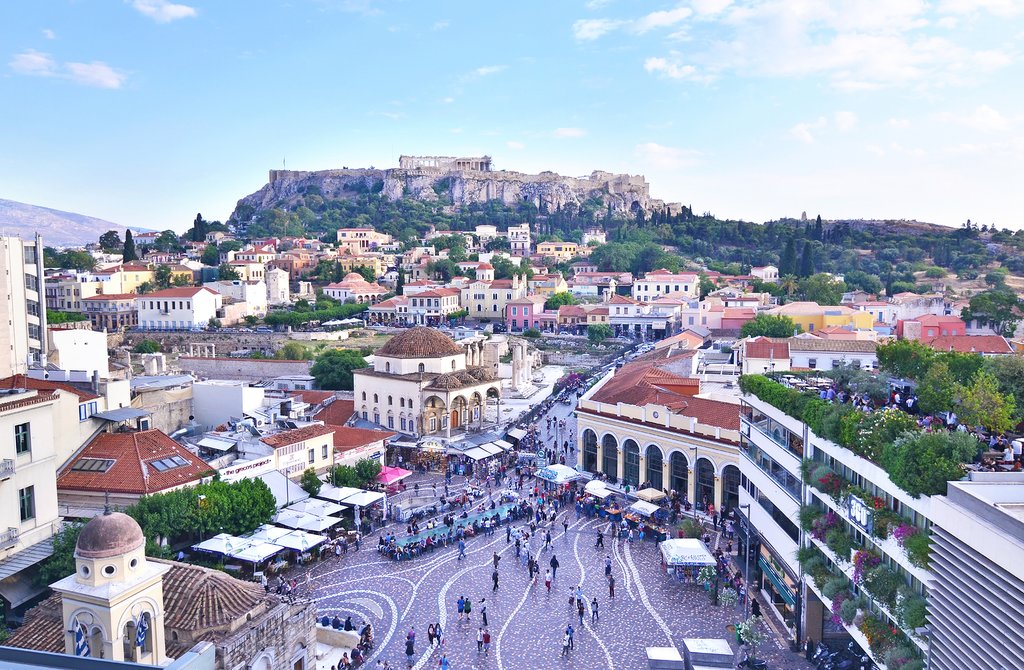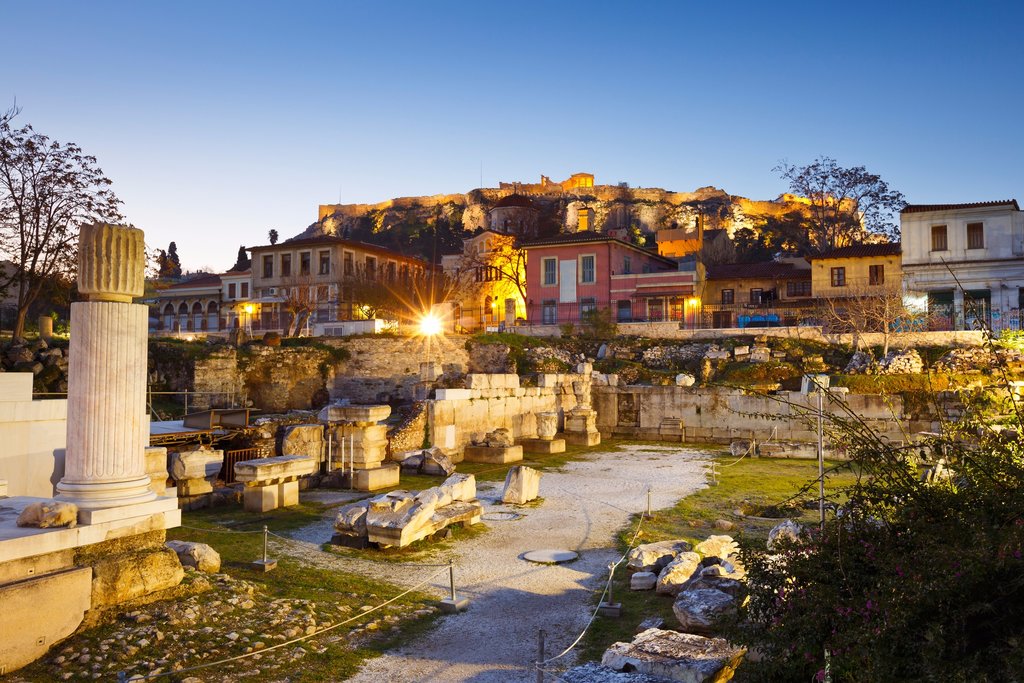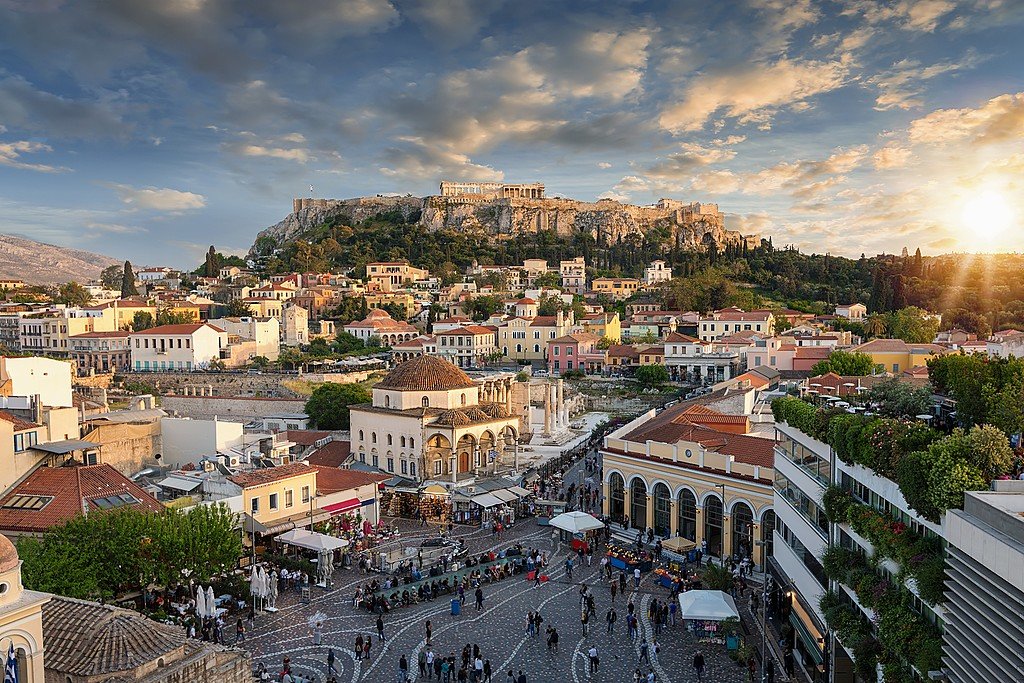Highlights
- Embrace your inner dancing queen on Skopelos island
- Climb to the clifftop monasteries of Meteora
- Trek through the Zagori stone villages
- Taste a food panorama on Corfu
Brief Itinerary
| Day | Highlights | Overnight |
|---|---|---|
| Day 1 | Arrive in Athens, Welcome Dinner | Athens |
| Day 2 | Acropolis and Ancient Greek Mythology Tour | Athens |
| Day 3 | Mount Pelion & Thermopylae | Volos |
| Day 4 | Travel to Skopelos Island | Skopelos |
| Day 5 | Explore Skopelos | Skopelos |
| Day 6 | Mamma Mia and Skopelos Highlights Tour | Skopelos |
| Day 7 | Travel to Meteora | Kalabaka |
| Day 8 | Travel to Zagori | Zagori |
| Day 9 | Zagori Bridges and Villages Hike | Zagori |
| Day 10 | Travel to Corfu | Corfu |
| Day 11 | Corfu Food Tour | Corfu |
| Day 12 | Palaces of Corfu | Corfu |
| Day 13 | Return to Athens, Sunset at Cape Sounion | Athens |
| Day 14 | Depart Athens |
Detailed Itinerary
Day 1: Arrive in Athens, Welcome Dinner

Welcome to Greece! You'll begin your trip in Athens, home to both the iconic Acropolis and so much more. The mythology of this spectacular city precedes it, with towering temples to Classical deities and the ruins of ancient marketplaces rubbing shoulders with lively nightlife, crowded flea markets, and contemporary cuisine. Make the most of your time in the city at some of these spots:
- Check out the views of the can't-miss Parthenon. (Pro tip: The Parthenon is the temple, the Acropolis is the hill.) This temple to Athena has enchanted visitors since its construction was completed in 438 BC. It's probably the first thing that comes to your mind when you think of ancient Greece and is visible from many of the city's high points.
- Stop at the sprawling National Museum for a crash course in ancient iconography. Be sure to seek out the room housing the Antikythera mechanism, essentially an ancient astronomical computer.
- Visit a smaller archaeological site at the Tower of the Winds, then stroll down neighboring pedestrian Aiolou Street to stop at shops and cafes.
- Find your perfect souvenir or sun hat in the busy stalls of the Monastiraki flea market.
In the evening, you'll sit down to enjoy either a welcome dinner with views of the Acropolis or wine tasting in a bar in downtown Athens.
Day 2: Acropolis and Ancient Greek Mythology Tour

Experience the ancient stories surrounding you with today's guided mythology tour. You'll meet your guide and storyteller at the Temple of Olympian Zeus, then head to landmarks around the city including the Acropolis, ancient cemetery at Kerameikos, and the Agora. The myths that founded the city and are featured in its retellings for generations will accompany as you go, with stories of Zeus, Athena, Poseidon, Dionysus, and more. Hear both the stories themselves and the historic facts behind them, adding resonance to the archaeological ruins you will visit during this four-hour tour.
Make your way over to explore the Acropolis Museum on your own after your tour (or join a guide if you'd prefer). Named one of the ten best museums in the world by National Geographic, this modern museum houses a multitude of artifacts removed from the hill of the Acropolis for safekeeping to provide insight into ancient religious practices and daily life. Linger for lunch in the museum's cafe, with views of the artifacts' former hilltop home.
As night falls, you may be able to visit the Athens Observatory to learn about the constellations overhead and take a look through the telescope. Its hours vary seasonally and by day of the week.
Day 3: Mount Pelion & Thermopylae

Hit the road early today to continue your journey. Your first stop is Thermopylae, where Leonidas of Sparta battled the Persian army in 480 BCE. It's now transitioned to a more relaxing way of life, taking its name's translation of "hot gates" a bit more literally for its therapeutic sulphur hot springs.
Continue to the coastal city of Volos and take in both the sea and mountain views as you stroll along the city streets and pedestrian waterfront path. Volos's central port once tied together trade from Europe, the Middle East, and Asia, an influence you can still see as you walk through its squares. Stop in one of the tsipouradika to sample the local alcoholic specialty of tsipouro, a dstilled brandy made from wine press pomace, and its accompanying mezze small plates.
You'll also visit the green landscapes and stone villages of Mount Pelion. You'll start with the area's traditional villages, including Makrynitsa, Vyzita, and Milies, home to a famous traditional local train on the Pelion narrow-gauge railway. You'll then continue on to Tsagarada and Agios Ioannis on the Aegean coast.
In addition to its scenery, Mount Pelion is also known for being the mythological home of the centaurs, creatures who were half-human, half-horse. Keep an eye out in the greenery and you never know what you might spot.
Day 4: Travel to Skopelos Island

Set sail for Skopelos in the Sporades island group today. Legend has it the island was founded by Peparethos, son of the god of wine Dionysus, and Ariadne, princess of Crete. In antiquity it was known for its wines; now it's better known as the filming location for Mamma Mia. Either way, revelry awaits.
Skopelos town is the island's capital, seated on a hill on the northern coast. With its medieval castle, stone houses, narrow streets, and Byzantine churches, the town encapsulates what it means to be a typical Greek island community.
Day 5: Explore Skopelos

In addition to its main town, Skopelos is also home to three other main settlements.
Traditional Glóssa is the second biggest settlement on the island, also known as "the tall village” according to the poet Papadiamantis—probably due to the many ruins of ancient towers discovered in the area. It is distinctive for its traditional, noble character and the ruins of ancient towers and buildings that have been discovered around the area.
Nearby Palió Klíma is also known for being especially picturesque, despite the damage it suffered during the earthquake of 1965. Néo Klíma, also known as Élios, is a newer town, built in just 1981 below the forest of Vathias and near Hovolos beach.
Chat with a local specialist who can help organize your trip.
Day 6: Mamma Mia and Skopelos Highlights Tour

Today's six-hour guided tour will take you around to all the island highlights, with a special focus on the ones that brought Skopelos onto the big screen in Mamma Mia.
You'll start at the Agios Ioannis chapel, where the film's wedding scene was filmed. Hike up all 199 steps to get to the top or just relax on top of the nearby rocks and take in the views.
Stop at an olive press in Glossa village to learn about Skopelos olive oils as you make your way to Kastani beach. At the beach, you'll hear more about the filming on the island as you relax in a beach bar on the sands where 10 days of filming took place and have the chance to hop in the water.
Your next stop is Agnontas beach, for more swimming or lunch in a beach taverna. Then head back to Skopelos town, but make sure you keep an eye out for Cape Amarandos and its signature three trees protruding into the water on the way.
Day 7: Travel to Meteora

Head across the Central Greece countryside to visit the famous monasteries of Meteora. These clifftop monasteries, including Megalo Meteoron and Agios Stefanos, sit perched atop high rock formations but are still inhabited and used by monks and nuns today. The area has been named a UNESCO World Heritage site and is one of the largest pilgrimage sites in Greece.
Meet your guide for three hours among the monasteries. You'll see all six of the monasteries, with visits inside one or two of them for a glimpse of what the ninth-century monastic life may have been like.
You'll tread the same paths that monks used for hundreds of years to reach these holy places, perched close to 1,000 feet in the air above the canyons of the Pindos range. Before the paths were constructed, the monastery residents used nets and rope ladders to hoist goods (and sometimes their fellow clergy) to the clifftops.
Day 8: Travel to Zagori

After breakfast, head to the fairytale Zagori Villages. This cluster of more than 40 hillside villages hides its well-preserved stone structures among the snowcapped mountain peaks, rivers, and gorges of Pindos, built amphitheatrically amid unspoiled landscapes.
Whether you choose to linger under the trees, explore old monasteries, or visit the stone mansions of well-known residents, you're sure to find something to enchant you. Though Zagori is most popular as a winter destination, the mountain towns are equally as charming amid autumn foliage or in spring and summer when the peonies and hydrangeas bloom.
Many of the villages are on the List of Traditional Settlements of Greece, a testament to their unchanged nature over the years. Your local specialist will provide you with a custom guidebook to help you decide where to wander.
Day 9: Zagori Bridges and Villages Hike

Discover the rest of the Zagorichoria, villages of Zagori, in the Pindos mountains, the ideal spot for fairytale exploration.
Due to the unique flora and fauna present in the region, it's been designated a national park with strict preservation rules. You'll take an easy guided half-day hike (great for families), taking in views of the surrounding scenery and learning about the history and culture of the region. It's a beautiful walk among the stone houses, small farms, and river bridges, which were built with a special technique believed to be unique to the region.
Stop at the sixteenth-century Monastery of Pagia Spiliotissa for some bonus exploring, built atop a rock overlooking the Voidomatis river. The village of Vitsa makes an ideal stop for lunch, especially if you can find the area's mushroom-hunting expert. Spend the rest of your day resting and enjoying the slow pace of life in this region.
Day 10: Travel to Corfu

Today you'll travel to the island of Corfu in the Ionian Sea. Watch for the many species of marine mammals that call the surrounding waters home, and see why Odysseus was able to recuperate from his mythological journeys here.
The city of Corfu, the island's capital, sits between its two guardians of the Old Fort and New Fort. The former was built in the thirteenth century and is surrounded by a seawater moat. It hides a slew of iconography, including the Porta Sopranza, winged lions of Saint Mark, and the Doric-inspired Church of St. George behind its walls. The New Fort on the northwestern border, meanwhile, boasts cubist military architecture.
You'll receive a personal guidebook from your local specialist to enhance your explorations on your arrival. See the sandstone beaches, Pompeiian-inspired Achillion Palace, Pontikonisi Island, and Mon Repos aristocratic villa and gardens with local tips close at hand.
Day 11: Corfu Food Tour

Eat your way around the Old Town on this guided food tour. You'll spend three hours sampling everything Corfu has to offer, noticing its traditional roots and Italian influence along the way. Meet the players of the local food scene as you learn about the history of Corfiot food and ingredients and visit the open-air markets. Your samples will include loukomades (fried dough with honey), spinach and cheese pies, kumquats, cold cuts, and seafood mezze, along with ingredients like traditional butter and cream, olive oil, and plenty of ouzo to wash it down.
Don't leave the Old Town at the end of your tour, but instead spend some time walking off all that food around this UNESCO World Heritage site. Look up to see the crisscrossing balconies indicative of Corfu's Neapolitan influence or have a seat in Spianada Square to watch the city life go by.
Day 12: Palaces of Corfu

Corfu has been known for its aristocratic elegance, home to many royal families over the course of its history. Today's 6-hour guided tour takes you to their former homes, complete with scenic surroundings and views of the Ionian Sea.
The first stop is the Achilleion Palace built by Princess Sisi, empress of Austria. The empress was known for her love of beauty and greatly admired Greek mythology. The palace is set up to honor Achilles and her perception of him as a character who represented human strength and vulnerability.
Next up are the Old Palaces, also known as the Palace of Saints Michael and George. These palaces were built by the British in the Roman architectural style, with a complex of halls and buildings and formal gardens. Originally intended to house the British Lord High Commissioner of the Ionian Islands, they're now home to the Corfu Museum of Asian Art along with two other art galleries.
Wrap up with the Mon Repos Palace, situated atop a hill that archaeologists believe was once home to the ancient city of Corfu. The palace was built by a British commissioner as a gift to his Corfiot wife and inspired Princess Sisi to build her own palace.
Spend the evening enjoying one of Corfu's delicious local specialties in a restaurant in the Old Town, such as sofrito, thin slices of fried veal with white sauce made of garlic, vinegar and freshly ground parsley, or pastitsada, thick pasta with rooster or beef.
Day 13: Return to Athens, Sunset at Cape Sounion

Return to Athens in the morning. After you've settled back into the city, you'll be transferred down to the Athenian Riviera, full of both history and stunning island views. Your adventure will take you along the coast to visit the Temple of Poseidon, while being provided with historical background on the way. The views overlook the Saronic Gulf, with one of the best sunset views Greece has to offer. Sip a complimentary beverage and take in the sunset while you listen to music and immortalize the moment with a Polaroid-style photo.
You'll be transferred back to your lodging in the evening just in time for a late (Greek-style) dinner. Or, if you're not ready to call it a night, you can request a drop-off at some of the most popular beach bars to dance until the sun comes up.
Day 14: Depart Athens

Time to say farewell to Greece. Enjoy your final Athenian breakfast and sneak in some last-minute exploring before your transfer to the airport.


